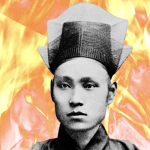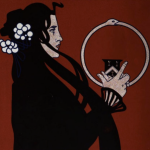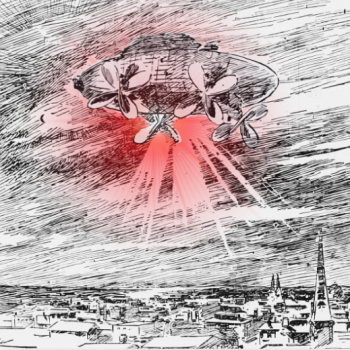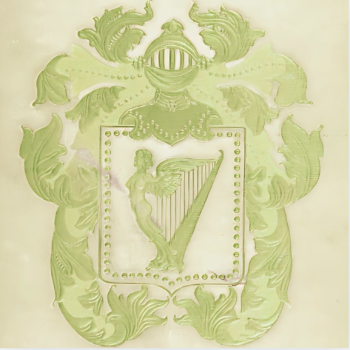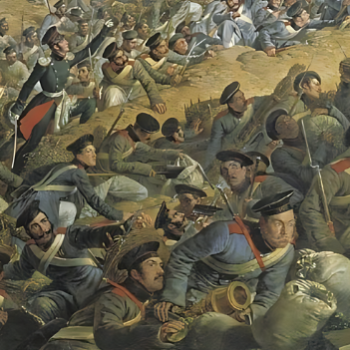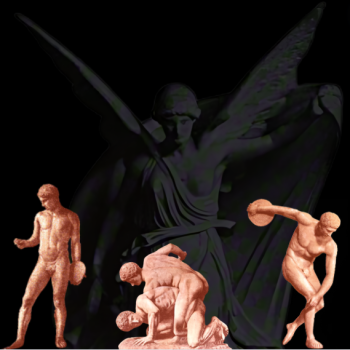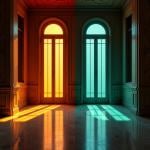As mentioned in a previous post, the first “Theosophical Society” in California began on October 12, 1885 by Anna Kimball and George Chainey (publishers of the proto-New Age journal, The Gnostic.)[1] Meetings were held at 112 McAllister Street in San Francisco, but the “branch” was both short-lived and unsanctioned by the American Board of Control (of Theosophy.)[2] The first official charter for a Branch in San Francisco was issued in 1885, and formed as the Golden Gate T.S. in March 1886. Its founding members were Theodore Guster Edward Wolleb (President.) Martha Bangle (Treasurer,) and Isaac B. Rumford.[3] It was said that many members of the Golden Gate Branch were former Spiritualists who found the Spiritualist explanations unsatisfactory.[4] One member stated:
They were unable to find in the alleged agency of the dead an adequate cause for effects, and they turned to Theosophy for a solution of the mysteries of life and death and found it in the exposition of natural laws which our philosophy gives. All the apparently inexplicable phenomena of Spiritualism and thought transference are readily explained when once the laws that govern the universe are understood […] Some of us who have seen and experienced more than some others, know that these things are so. We know that they are neither marvelous nor supernatural. To us there is nothing incredible in the things that were done by Madame Blavatsky. That she could by the exercise of her will power, compel a book, for example, to come to her hand from some distant place was perfectly natural. She could impress her thought upon the mind of another person thousands of miles away. That is easily understood. The molecular vibration induced by her thought was so intense, and far-reaching, that it could be projected to an immense distance and set up similar vibration in the brain molecules of the other person. It was simply thought transference. Her thought waves were so much stronger and persistent than our ordinary thought waves that they carried farther. That was all.[5]
Around the same time that the Golden Gate T.S. formed, and Branch in Los Angeles was established with leading members being Louise A. Off and Charles Wilson Bush.[6]
LOUISE A. OFF
Louise A. Off (1864-1895,) born in Newville, Wisconsin, was the daughter of immigrants, Charles Off (German) and Louisa Off (Swiss.)[7] The family lived for some time in Cedar, Iowa, but Off received her education in both Fond du Lac and Plymouth (Wisconsin.)[8] In the early 1880s, the family moved to Los Angeles, where Off joined the Theosophical Society in 1886.[9] At just twenty-one years old, she would be a pioneering figure in Theosophy in Southern California.
It was stated that: “[Off] was frail in body, gentle in manner, lofty in idea, wonderfully gifted with metaphysical powers, although young in years, she was held in reverent esteem by all […] her mental grasp of the most refined themes was remarkable.”[10] Her essay, “The Astral Light,” being a fine display of her poetic soul. “The Astral Light,” Off writes, “is the great record book upon whose pages every thought and act of differentiated consciousness is engraven, there to be read by the individual who has learnt the secret of exalting his vibrations until they become synchronous with the waves of this finer element.”[11] Despite her sincere attunement to the finer world of spiritual nature, she was suspicious of the charismatic displays of “astral athleticism,” and she believed “such statements inflame the imaginations of the weak-minded.”[12] Not long after joining, she proposed the idea of a school for occult philosophy to be established in Southern California.[13] In the spring of 1886, she wrote a letter to Judge asking his advice on the matter.[14]
Theosophy slowly gained traction. William J. Colville, a Spiritualist Medium (originally from England) joined the Golden Gate T.S. in February 1888.[15] By the spring of that year, he was delivering lectures on a tour of California whereby he advocated for amicable relations between the competing new religiosities (Theosophy, Christian Science, Spiritualism, etc.)[16] The first major article to the discuss Theosophical cosmology in California , however, was Ella Sterling Cummins’s “Our Theosophists,” in the July 1, 1888 issue of The San Francisco Examiner. When describing the Golden Gate Branch, Cummins writes:
Local Theosophy is rather bewildering. To see the devotion with which certain ladies and gentlemen attend dissertations on [Theosophical] themes would make the church people tremble with outraged feelings if they could see them. Three and four times a week refined and gentle-minded ladies and a number of serious-minded men are to be found sitting for two hours at a time, during business hours even, listening to the expounding of Theosophical truth.[17]
A week later, William Emmette Coleman responded to the article with a letter to the same paper, claiming that Blavatsky was “a splendid fraud.”[18] Coleman had been a nuisance to the Theosophists since the early days of the Theosophical Society.[19] According to Judge: “Coleman [was] a Spiritualist [and] a clerk in the Quartermaster’s Department of the army, at the Presidio. He writes letters to some greasy Spiritualistic papers, and edits one himself, The Carrier Dove. Coleman’s an ass of the finest breed.”[20] Richard Harte (of the Theosophical Publication Society, London) responded to The San Francisco Examiner, stating:
[Coleman] seems to belong to a class of creatures that perform a useful but extremely disgusting function in the economy of nature. Such individuals as he is correspond in the intellectual and moral world to those organisms that devour decaying matter and fatten on the putridity which they themselves help to originate, thus assisting the very necessary process of disintegration in dead bodies.[21]
Back in Los Angeles, a body called The Mystic Society, held its first meeting at the Odd Fellows’ Hall on August 30, 1888. It advertised itself as a series of public lectures comprised of expositions of “mysticism, mesmerism, mind-reading, Greek, Hindu, medieval and modern Theosophy, Occultism, Mental Healing, Spiritualism and kindred subjects.”[22] The venue (Odd Fellows’ Hall) was certainly appropriate. The Odd Fellows (a Fraternal Order akin to Masonry,) which experienced something of an uptick in popularity in Los Angeles, would host their National Convention in that city just three weeks after the Mystic Society had their first meeting.[23] It created a stir in the city for a moment, but enthusiasm waned by the end of October 1888.[24]
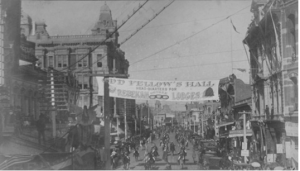
The Odd Fellows’ Conclave September 18, 1888.[25]
Though it was not a Branch of the Society, it was “in the hands of Theosophists.”[26] It’s likely that Off was one such Theosophist. One such Theosophist who was certainly involved was James Morgan Pryse (1859-1942,) “a young man of dark complexion, small eyes, and a lot of charts,” who was holding public meetings in the summer of 1888 “at which theosophy and mysticism were boldly proclaimed, much to the amusement of the press, but to the profit of those who seek.”[27]
Pryse was born in New London, a suburb of Cincinnati, Ohio, on August 14, 1859 to Welsh immigrants, James and Mary Pryse.[28] “During the most impressionable years of childhood I lived in a Welsh community in Minnesota,” Pryse would say, “among a people who believed in fairies, saw ghosts occasionally and had other psychic experiences, of which they spoke freely.” His father, James Sr., was a Presbyterian minister in Cincinnati, and being a minister’s son, James received his education on the road, traveling from town to town in America while learning Latin and Greek in preparation for college in Crawfordsville, Indiana. This less-than-ideal learning environment, unsurprisingly, was unsustainable, resulting in Pryse’s inevitable burnout which “spoiled these plans.” Pryse then began to read law, and at seventeen, was ready for the bar. Not caring to spend four years as a clerk, however, he went to Red Cloud, Nebraska, and the freedom of the frontier. There he operated a photograph gallery, but sold it and entered a printing office where he learned the mechanics of that trade. It was also here that he edited a local newspaper, and with his brother John, published other papers in various towns. It was around the time that the Theosophical Society was established in New York, and it was here where he first read a brief dispatch “a society for the study of Oriental literature.” It was hauntingly familiar to Pryse, who states: “I wanted to write to that Madame Blavatsky (whose name I then read for the first time); but the dispatch gave no address.” The brother then started and sold printing offices in succession throughout the country (Anaconda, Montana; Prescott, Michigan; St. Paul, Minnesota,) spent some time in Florida, and then back to the Northwest. It was in Minnesota, in January 1886, where he gave up printing and was admitted to the bar in the Circuit Court for the Eighth District of the State.
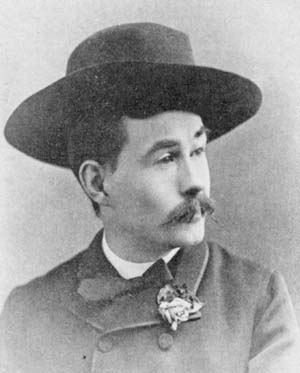
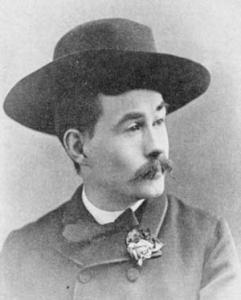
James Morgan Pryse.[29]
He then went to Lacrosse, Wisconsin, to practice law, but instead took a position as telegraph editor on The Republican Leader. He became what Americans termed “disgruntled,” and joined the leaders of a proposed Socialist model community in Sinaloa, Mexico, called the Topolobampo Colony. While Pryse worked in the printing department of that community, he lived in Hammonton, New Jersey. Through this line of work, Pryse met John W. Lovell, the publisher of the colony’s paper, The Credit Foncier Of Sinaloa. Lovell, a Theosophist, would publish the first book on reincarnation within two years’ time.[30] Other Theosophists connected with the Topolobampo Colony were Davitt D. Chidester (who would be the president of the Philadelphia Branch for some time,) and Marie Howland, author of a book titled Papa’s Own Girl. It was a work which, like Bellamy’s Looking Backward, was a Socialist utopian novel. (Howland would help establish a Theosophical Branch in Alabama in the years ahead.)[31] During this time, Pryse got into correspondence with the Theosophist, Julia Campbell Ver Planck, who was assisting Judge with The Path . Julia told Pryse of the Theosophical Society, and advised him to study Isis Unveiled, Esoteric Buddhism, and other Theosophical literature. Pryse corresponded with Julia for years, and occasionally with Judge, whom he “came to be well acquainted “in the astral [plane,]’” after he had settled in Los Angeles in 1886. In August 1887, Pryse joined the Theosophical Society in Los Angeles.[32] He was soon reunited with his brother John, who joined the Society in April 1888.[33] It was while in Los Angeles that James visited Blavatsky in London via astral projection, where she told him that he would soon be doing important work for the Society.[34] (Pryse would help establish the Aryan Press in New York and the H.P.B. Press in London.)
THE NATIONALISTS
While Pryse was working on the Theosophical Press Scheme, Off would be connected with The Nationalist Club, a movement spear-headed by the Boston Theosophists. The First Nationalist Clubs in Boston had already put forth a declaration of principles, and the thought of forming a similar club in Los Angeles was discussed among friends of progressive ideas. Imbued with the thoughts of the “new declaration,” Off called a meeting at her home (the corner of Northern and Union) in May 1889.[35] One of the Theosophical-Nationalists in Off’s group was Marie Agnes Walsh of the Golden Gate T.S.[36] Like Off, Walsh believed in the salvific potential of Theosophical pedagogy. “The Theosophical Society has before it the great work of changing public opinion in regard to education,” Walsh would write.[37] “One of the most striking of recent phenomena [was] the spread of socialistic ideas under the name Nationalism,” it was said. “It [was] scarcely more than two years since Looking Backward was published. Yet […] there [was] hardly a State in the Union that [had] not one or more clubs devoted to the dissemination of the nationalist ideas.”[38] (Similar clubs would follow Off’s lead, and soon form in San Diego, and San Francisco.)[39] Only a dozen people were present at Off’s first meeting, but it was decided to adopt the declaration of principles of the Boston Club.[40] At the following meeting she was named Secretary of the California Nationalist Club.[41] (The first meeting with officers was held August 9, 1889, at the Universalist Church with attendance of forty-eight.)[42]
This practical application of Theosophical principles might explain the article Off contributed to The Theosophist in May 1889 in which she stated: “In the West [Coast] we are learning to strive above all to be practical and to overcome the conventialisms that have been projected into the domain of Theosophy in its exoteric expressions.”[43] Blavatsky, after all, had written favorably of Bellamy’s work in her 1889 book, The Key To Theosophy, stating: “The organization of Society depicted by Edward Bellamy in his magnificent work Looking Backwards, admirably represents the Theosophical idea of what should be the first great step towards the full realization of universal brotherhood.”[44]
The organization of the second Nationalist Club in San Francisco a few months later began the second stage of the movement. This club was established by a large number of Socialists who had long labored for the spread of Socialism, and saw this as a golden opportunity. The object of the organization was to attract converts, and to change the character of those already established. It was said that the two new Socialistic societies (the Nationalists and the Bliss’s Christian Socialists,) had rapidly spread in San Francisco in late Summer 1889.[45] It movement spread with equal fervor throughout the rest of California, in about fifty towns and cities, with each club catering to the unique interests of each locale. In San Francisco the original club was called The Pacific, while the second was called The Central (two other clubs were also established.) In Los Angeles the movement showed the greatest strength, with seven clubs working in harmony with one another, while San Jose had two clubs. The extreme rapidity of growth was largely the result of the method of organization adopted. Organizers were sent throughout the State, and addressed meetings, and established clubs wherever they went. Socialists found no difficulty in standing on Nationalist platforms, while many who feared the name Socialism found no difficulty in being an active Nationalist. “Nationalism has put a silk hat on Socialism,” it was said. The Nationalist press in California consisted of four papers, The Pacific Union, The Abolitionist, The Weekly Nationalist, and The California Nationalist, the last being under the editorial management of W.C. Owen.[46] William J. Colville even contributed many articles on the subject in his new journal, The Problem Of Life. “No journal devoted to a promulgation of the advanced thought of the day can afford to be silent on the question of Nationalism,” Colville declared in the first issue.[47]
BERT KEIGHTLEY
When the London Theosophist, Bert Keightley, toured the West Coast of America in late 1889 and early 1890, he was compelled to speak on the subject.[48] This he did on January 26, 1890, at a meeting in the Temperance Temple of Los Angeles. W.C. Owen (editor of The California Nationalist) being the moderator of the discussion.[49] Bert started out with the proposition that Theosophy and Nationalism rested on the same basis, but that Theosophy was “the intellectual explorer into the fields” where Nationalism was “endeavoring to be the practical exponent of the doctrine of the universal brotherhood of man.” Nationalism, said Bert, applied the principles which Theosophy had preempted, and the difference between the two movements was the application of principles which Theosophy had discovered. Bert stated:
You may urge cooperation as the solution of the pressing problems of humanity, and you naturally appeal to the selfish element of humanity; that is, under cooperation, how much better off you will be; and that no one will then suffer as they do now. But after all, you leave untouched the brutal selfishness of humanity. You simply substitute one form, of selfishness for another. Theosophy, however, takes up this selfishness and attempts to eliminate it. When I first read Mr. Bellamy’s book I felt that he had struck a keynote that would bring about Theosophy in actual life. Practically all Theosophists are Nationalists Take the universal brotherhood of man, as Nationalism teaches. That is all very well, but you don’t attempt to prove it by scientific reasoning, and Theosophy supplies that. Theosophy holds that men are one; that there is a unity in humanity; and that it is impossible for the individual to leave the mass or advance alone without the whole of humanity advancing. You oppose competition by the spiritual or divine law of cooperation. Theosophy does the same. But Theosophy is more; it is the elimination of selfishness, and Nationalism is simply the application of its principles.[50]
Bert continued his critical analysis of the two movements, which an unenthusiastic audience. He continued to say that Nationalism, pure and simple, bore the seeds of its own destruction in its selfishness, if left to itself, and that for any reform to be permanent, it must be “deeply laid in its basis, or it will not stand the test of time.” Nationalism would only endure if mankind realized the fact that it “must not simply substitute one form of selfishness for another.” Theosophy, he contended, would supplement Nationalism, and give it the enduring principle which it lacked. Illustrating his position, Bert said that if Bellamy’s ideas were all realized, and everyone had all their needs met, it still did not solve the question. An inherent idea in human nature was ambition and a desire for power, and if the struggle for existence was removed, it did not remove selfishness. W. C. Owen then made a short address, in which he stated that he did not criticize Bert, but felt that he did not realize “how much nearer Theosophy and Nationalism [were.]”[51]

Bert Keightley. (Source: Wiki)
PACIFIC COAST COMMITTEE
It was during this visit that Bert held a meeting at the Golden Gate Lodge, and suggested the adoption of a practical scheme of Theosophic work on the Pacific Coast, “whereby San Francisco should become a Centre, from which would emanate a continued and steady stream of influence and actual work.”[52]
This was the beginning of the Pacific Coast Committee of the Theosophical Society. An Executive Committee was organized with a Chairman, Vice-Chairman, Corresponding Secretary, and Treasurer (who also acted as Recording Secretary.) Five Members constituted a quorum, and its meetings and business was held at 13 Mason Street, San Francisco, “Head Quarters Pacific Coast.”
An idea was drawn up, the Theosophical Lecture Bureau, whereby skilled speakers would “work up the smaller towns and by degrees spread a network of Branches all over the country.”[53] (A plan not dissimilar to that which the Nationalists adopted during their quick rise.) This scheme would be adopted by Theosophists across America, and evolve in efficiency through trial and error until there was a group of field lecturers who “covered the U. S. with a network of Theosophical lines with Judge as the ‘king-pin’ so to speak at the strategic points.”[54]
“HIGH OLD THEOSOPHER”
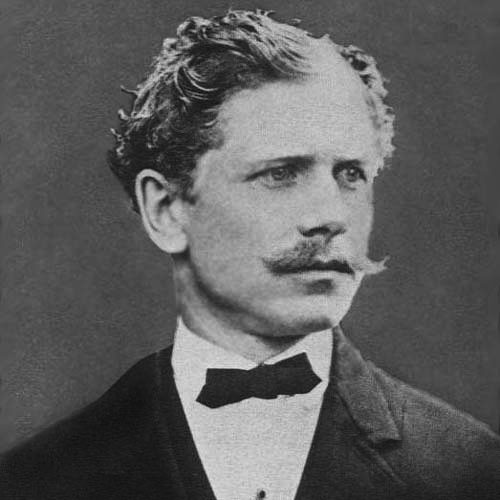
Ambrose Bierce. (Source: Wiki)
By 1891, Theosophy was becoming so popular on the West Coast, that even The Sun (New York) took notice. “Out in California, Theosophy has taken a strong hold on the people, and they are booming it at a great rate.” The Sun added: “It appears also that this enthusiasm had a contrapuntal of scorn, ridicule, and contumely […] In San Francisco a satiric poet struck some notes of finest scorn from his lyre, and composed some verses that lampooned [W.Q.] Judge.”[55] The unnamed “distinguished local satirist,” was none other than Ambrose Bierce.[56] This is the poem:
High old Theosopher,
William Q. Judge,
Spook-priest philosopher,
Prophet of Fudge,
Welcome among us,
Blavatskian man;
Chin us and tongue us
As hard as you can.
If that is your aim
Never we’ll grumble;
Maybe we’ll tumble
At last to the game.
O, Gulielmus
Judex, begin
Pray overwhelm us,
Like beetles in gin,
With bosh from within—
A deluge that few can
Escape, though, as you can—
Aboard of your chin.
Billows of babble
On oceans of stuff,
Oodles of gabble
And eedles of guff
Worthy of Sludge—
That is the mystical,
Theosophistical,
Doctrine expounded by
William Q. Judge,
Spooker-in-Chief in the
Temple of Fudge.[57]
~
[We will take a look at the practical manifestations of Theosophy and Nationalism in California, as well as some of the main players in the next installment.]
SOURCES:
[1] Chainey, George. “Contents For July.” The Gnostic. Vol. I, No. 1 (July 1885): i.
[2] “The Theosophists.” The San Francisco Chronicle. (San Francisco, California) October 12, 1885.
[3] Theosophical Society General Membership Register, 1875-1942 at http://tsmembers.org/. See book 1, entry 3479. (Website file: 1B:1885-1890) Theodore Guster Edward Wolleb; Theosophical Society General Membership Register, 1875-1942 at http://tsmembers.org/. See book 1, entry 3748. (Website file: 1B:1885-1890) Martha Bangle. (9/8/1886); Theosophical Society General Membership Register, 1875-1942 at http://tsmembers.org/. See book 1, entry 3564. (Website file: 1B:1885-1890) Isaac B. Rumford. (2/2/1886)
[4] Rambo states: “They were unable to find in the alleged agency of the dead an adequate cause for effects, and they turned to Theosophy for a solution of the mysteries of life and death and found it in the exposition of natural laws which our philosophy gives. All the apparently inexplicable phenomena of Spiritualism and thought transference are readily explained when once the laws that govern the universe are understood […] Some of us who have seen and experienced more than some others, know that these things are so. We know that they are neither marvelous nor supernatural. To us there is nothing incredible in the things that were done by Madame Blavatsky. That she could by the exercise of her will power, compel a book, for example, to come to her hand from some distant place was perfectly natural. She could impress her thought upon the mind of another person thousands of miles away. That is easily understood. The molecular vibration induced by her thought was so intense, and far-reaching, that it could be projected to an immense distance and set up similar vibration in the brain molecules of the other person. It was simply thought transference. Her thought waves were so much stronger and persistent than our ordinary thought waves that they carried farther. That was all.” [Kelly, Allen. “Cult Of The Theosophists.” The San Francisco Examiner. (San Francisco, California) January 8, 1893.]
[5] Kelly, Allen. “Cult Of The Theosophists.” The San Francisco Examiner. (San Francisco, California) January 8, 1893.
[6] Theosophical Society General Membership Register, 1875-1942 at http://tsmembers.org/. See book 1, entry 3580. (Website file: 1B:1885-1890) Louise A. Off. (1/12/1886); Theosophical Society General Membership Register, 1875-1942 at http://tsmembers.org/. See book 1, entry 3582. (Website file: 1B:1885-1890) Charles Wilson Bush. (2/11/1886.)
[7] “United States Census, 1880”, , FamilySearch (https://www.familysearch.org/ark:/61903/1:1:MNHJ-1KH : Sat Mar 09 03:06:09 UTC 2024), Entry for Charles Off and Louisa Off, 1880.
[8] “United States Census, 1870”, , FamilySearch (https://www.familysearch.org/ark:/61903/1:1:MDJG-NBH : Tue Mar 05 07:11:28 UTC 2024), Entry for Charles F Off and Louisa Off, 1870.
[9] Theosophical Society General Membership Register, 1875-1942 at http://tsmembers.org/. See book 1, entry 3580. (Website file: 1B:1885-1890) Louise A. Off. (1/12/1886); “Mirror Of The Movement.” The Path. Vol. IX No. 11 (February 1895): 405-410;.
[10] Brown, Clara Spalding. “Midland Women In California.” The Midland Monthly. Vol. IV, No. 5 (November 1895): 393-410.
[11] Off, Louise A. “The Astral Light.” Theosophical Siftings. Vol. III. (1890-1891) The Theosophical Publishing Society. London, England. (1891): 24-28.
[12] Off, Louisa A. “A Few Lines From California.” The Theosophist. Vol. X, No. 117 (June 1889): 524-525.
[13] While we don’t have the letter which she sent Judge, we can see from his response that her query related to a proposed retreat or school in California. In the Spring of 1887, she would propose just such a school in the April 1887 issue of The Platonist. Off states in part: “If the ideal Brotherhood, the germinating sprout uniting love and knowledge is to be stimulated into speedy growth it must be done by the cooperation of all spiritual forces upon one central and active basis, a basis which has practical instruction of the many in view. Our men and women should be educated to the idea of the great existing Unity by the natural method of progression, from the simple to the compound, from the concrete to the abstract. The school should consist chiefly of a lecture department devoted to esoteric theosophy, in which the Vedantins, Buddhists Pythagoreans, Rosicrucians, Gnostics and others will be reviewed, each in their interior nature, and interpreted by the most prominent philosophers of our own time, so that the identity of truth underlying multifarious expressions may be perceived and appreciated. To this end we would urge the establishing of a continental school of philosophy, to be sustained by the annual contributions on the part of those interested in the diffusion of a higher knowledge, or, in other words, in the preparation of the intellectual abode for the reception of the spirit. As to locality, no more desirable, semi-tropical country could be found than that Italy of America, Southern California, where mildness and serenity of climate pre vail the entire year with the exception of a few weeks of rainfall in February or March, and insures an eternal spring as well as constant productiveness.” [Off, L.A. “A School Of Philosophy.” The Platonist. Vol. III, No. 4 (April 1887): 185-190.]
[14] Judge wrote back, in part: “Such a place as you desire to make would, in fact, beyond question be a spiritual centre. At Adyar in India, we have the headquarters, and no doubt it forms a centre, not only from which forces radiate, but also towards which aspirations tend and it does much towards solidifying the whole body of Theosophists […] You must remember that we are all brothers of the third section (the lowest) in this country. When any theosophist has advanced into the second section he becomes a chela and comes under the personal guidance and teaching of some brother of the first section, and at a certain point in his development it becomes necessary for him to live in proximity with his Master. It seems to me that to give the institution at all the true character of a Theosophic lamasery all three sections of the society should be represented in it, so that, as matters now stand, it could at best be no more than a preparatory school, as it were, from which the aspirants for a degree must pass to a higher college or university[…]It seems to me that to give the institution at all the true character of a Theosophic lamasery all three sections of the society should be represented in it, so that, as matters now stand, it could at best be no more than a preparatory school, as it were, from which the aspirants for a degree must pass to a higher college or university.” [William Quan Judge to Louise A. Off. June 3, 1886] in Judge, William Quan, and A. L. Conger. Practical Occultism. Theosophical University Press. Pasadena, California. (1951.)]
[15] Theosophical Society General Membership Register, 1875-1942 at http://tsmembers.org/. See book 1, entry 4346. (website file: 1B:1885-1890) William J. Colville. [Golden Gate T.S. 734 Montgomery Street. San Francisco, California. (2/17/1888.)]
[16] “Advertisement: W.J Colville.” The San Diego Sun. (San Diego, California) April 14, 1888; “Mental Force.” The Oakland Tribune. (Oakland, California) June 11, 1888.
[17] Cummins, Ella Sterling. “Our Theosophists.” The San Francisco Examiner. (San Francisco, California) July 1, 1888.
[18] Coleman, William Emmette. “A Splendid Fraud.” The San Francisco Examiner. (San Francisco, California) July 8, 1888.
[19] See: Blavatsky, H.P. “The Knout.” The Religio-Philosophical Journal. Vol. XXIV, No. 2 (March 16,1878): 8.
[20] “Base Spirits Beset Judge.” The Sun. (New York, New York) April 5, 1894.
[21] Harte, Richard “More Theosophy.” The San Francisco Examiner. (San Francisco, California) August 19, 1888.
[22] “Mystic Society.” The Los Angeles Times. (Los Angeles, California) July 24, 1888.
[23] “Three Link Brethren.” The Los Angeles Express. (Los Angeles, California) September 19, 1888.
[24] “Mystic Mush.” The Los Angeles Times. (Los Angeles, California) October 22, 1888.
[25] The Odd Fellows’ Conclave Sept. 18, 1888, from the Nadeau Hotel Looking North on Spring St. Los Angeles, California: Pierce & Blanchard, 1888. Print.
[26] “Theosophical Activities.” The Path. Vol. III, No. 8 (November 1888): 259-263
[27] “Theosophical Activities.” The Path. Vol. III., No. 7. (October 1888): 235-236; “The Unknowable.” The Los Angeles Times. (Los Angeles, California) October 7, 1888.
[28] “Ohio, County Marriages, 1789-2016”, , FamilySearch (https://www.familysearch.org/ark:/61903/1:1:X8JQ-V77 : Fri Mar 08 14:08:33 UTC 2024), Entry for James M. Pryse and Mary Morgans, 1848.
[29] “Faces Of Friends: James Morgan Pryse.” The Path. Vol. IX, No. 3 (June 1890): 90-91.
[30] Theosophical Society General Membership Register, 1875-1942 at http://tsmembers.org/. See book 1, entry 3801. (Website file: 1B:1885-1890) John W. Lovell. (11/30/1886.)
[31] Lovell, John W. “Reminiscences Of Early Days Of The Theosophical Society: Part I.” The Canadian Theosophist. Vol. X, No. 1 (March 15, 1929): 1-5.
[32] Theosophical Society General Membership Register, 1875-1942 at http://tsmembers.org/. See book 1, entry 4042. (website file: 1B:1885-1890) James M. Pryce. [Los Angeles T.S. 42 Morris Street. Los Angeles, California. (8/7/1887.)]
[33] Theosophical Society General Membership Register, 1875-1942 at http://tsmembers.org/. See book 1, entry 4430. (website file: 1B:1885-1890) John M. Pryce. [Universal. 29 E. Second Street. Los Angeles, California. (4/23/1888.)]
[34] Pryse writes: “In those days many Theosophists were ambitious to become ‘chelas’ or ‘lay chelas’ by getting into communication with the Masters whom [Blavatsky] represented. Having no doubt that the Masters were being pestered by so many applicants, I refrained from any attempt to reach [Blavatsky] or her Master, or to attract their attention to my unimportant self. But my mind kept dwelling on Paracelsus, with a distinct impression that he was again incarnated; so I resolved to find him, if possible, and in my daily meditation concentrated my mind on him. One evening while I was thus meditating the face of [Blavatsky] flashed before me. I recognized it from her portrait in Isis [Unveiled,] though it appeared much older. Thinking that the astral picture, as I took it to be, was due to some vagary of fancy, I tried to exclude it; but at that the face showed a look of impatience, and instantly I was drawn out of my body and immediately was standing ‘in the astral’ beside [Blavatsky] in London. It was along toward morning there, but she was still seated at her writing desk. While she was speaking to me, very kindly, I could not help thinking how odd it was that an apparently fleshy old lady should be an Adept. I tried to put that impolite thought out of my mind, but she read it, and as if in answer to it her physical body became translucent, revealing a marvelous inner body that looked as if it were formed of molten gold. Then suddenly the Master [Morya] appeared before us in his mayavi-rupa. To him I made profound obeisance, for he seemed to me more like a God than a man. Somehow I knew who he was, though this was the first time I had seen him. He spoke to me graciously and said, ‘I shall have work for you in six months.’ He walked to the further side of the room, waved his hand in farewell and departed. Then [Blavatsky] dismissed me with the parting words, ‘God bless you,’ and directly I saw the waves of the Atlantic beneath me; I floated down and dipped my feet in their crests. Then with a rush I crossed the continent till I saw the lights of Los Angles and returned to my body, seated in the chair where I had left it.” [Pryse, James Morgan. “Memorabilia Of H.P. Blavatsky.” The Canadian Theosophist. Vol. XVI, No. 1 (March 15, 1935): 1-5.]
[35] “Death Record.” The Los Angeles Times. (Los Angeles, California) January 7, 1895; “Mirror Of The Movement.” The Path. Vol. IX No. 11 (February 1895): 405-410.
[36] Theosophical Society General Membership Register, 1875-1942 at http://tsmembers.org/. See book 1, entry 4521. (Website file: 1B:1885-1890) Marie Agnes Walsh. [Golden Gate T.S. (6/17/1888)
[37] Walsh, Marie A. “What Can Theosophy Do For Children.” The Path. Vol. V, No. 12 (March 1891): 368-371.
[38] Vassault, F.I. “Nationalism In California.” The Overland Monthly. Vol. XV, No. 90 (June 1890): 559-661.
[39] “The New Socialism.” The San Francisco Examiner. (Can Francisco, California) October 22, 1889.
[40] “News From The Clubs: Pacific Coast.” The New Nation. Vol. I, No. 3 (February 14, 1891): 51.
[41] “Nationalists.” The Los Angeles Times. (Los Angeles, California) June 10, 1889.
[42] Reid, Hiram A. History Of Pasadena. Pasadena History Company. Pasadena, California. (1895): 515-516.
[43] Off says in part: “The astral world is full of aping elementaries who are ever ready to impress images of Mahatmas, “long flowing robes,” [etc.] upon mediumistic natures. The fact that such matters are ventilated broadcast by the would-be seers is a proof of the delusion, for when once a mortal is so far advanced as to be brought normally and by synchronous vibration into the soul-sphere of these vast natures, it is not likely that he will hang the sacred boon. upon his sleeve, or put it in a dime-show. It is the blind bolting after the wonderful that drags as a dead weight upon the wings of Theosophy and destroys her freedom to do practical good. In the West [Coast] we are learning to strive above all to be practical and to overcome the conventialisms that have been projected into the domain of Theosophy in its exoteric expressions. The Bohemianism of western life is a stimulant to this endeavour, and the general population is inoculated with [a] habitual revolt against all dogmatic limitations.” [Off, Louisa A. “A Few Lines From California.” The Theosophist. Vol. X, No. 117 (June 1889): 524-525.]
[44] Blavatsky writes: “In order to awaken brotherly feeling among nations we have to assist in the international exchange of useful arts and products, by advice, information, and cooperation with all worthy individuals and associations (provided, however, add the statutes, ‘that no benefit or percentage shall be taken by the Society or the [F.T.S.] for its or their corporate services.’) For instance, to take a practical illustration. The organization of Society depicted by Edward Bellamy in his magnificent work Looking Backwards, admirably represents the Theosophical idea of what should be the first great step towards the full realization of universal brotherhood. The state of things he depicts falls short of perfection, because selfishness still exists and operates in the hearts of men. But in the main, selfishness and individualism have been overcome by the feeling of solidarity and mutual brotherhood; and the scheme of life there described reduces the causes tending to create and foster selfishness to a minimum.” [Blavatsky, H.P. The Key To Theosophy. The Theosophical Publishing Company. London, England. (1890): 44.]
[45] “The New Socialism.” The San Francisco Examiner. (Can Francisco, California) October 22, 1889.
[46] Vassault, F.I. “Nationalism In California.” The Overland Monthly. Vol. XV, No. 90 (June 1890): 559-661.
[47] Colville, W.J. “Notices.” The Problem Of Life. Vol. I, No. 1 (1889): 24-28.
[48] “Theosophical Activities.” Lucifer. Vol. VI, No. 31 (March 15, 1890): 66-80.
[49] “The Nationalists.” The Los Angeles Evening Express. (Los Angeles, California.) January 27, 1890.
[50] “Two Isms Together.” The Los Angeles Times. (Los Angeles, California.) January 27, 1890.
[51] “Two Isms Together.” The Los Angeles Times. (Los Angeles, California.) January 27, 1890.
[52] “Theosophical Activities.” Lucifer. Vol. VI, No. 31 (March 15, 1890): 66-80.
[53] “Theosophical Activities.” Lucifer. Vol. VI, No. 33 (May 15, 1890): 254-259; “Mirror Of The Movement.” The Path. Vol. VI, No. 9 (December 1891): 287-296.
[54] Theosophical Society General Membership Register, 1875-1942 at http://tsmembers.org/. See book 1, entry 8292. (website file: 1C:1890-1894) Leoline Leonard. [9201 Ellis Avenue, Chicago, Illinois. Chicago T.S. (4/6/92); Wright, Leoline Leonard. “Recollections Of A Theosophical Speaker. Pt. I.” The Theosophical Forum. (September 1838)
[55] “Booming Theosophy.” The Sun. (New York, New York.) December 9, 1891.
[56] “The General Secretary’s Tour.” The Path. Vol. VI, No. 8 (November 1891): 259-261.
[57] Bierce, Ambrose. “Prattle.” The San Francisco Examiner. (San Francisco, California) September 27, 1891.


